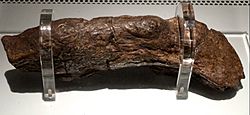Lloyds Bank coprolite facts for kids
Quick facts for kids Lloyds Bank coprolite |
|
|---|---|

On display at Jorvik Viking Centre
|
|
| Material | Palaeofaeces |
| Created | 9th century |
| Discovered | 1972 excavation, Pavement, York |
| Present location | Jorvik Viking Centre |
The Lloyds Bank coprolite is a very large piece of fossilised human waste. It was found by archaeologists in York, England. This discovery happened during an excavation of an old Viking settlement called Jórvík, which is now the city of York.
Contents
What is the Lloyds Bank Coprolite?
This amazing fossil was discovered in 1972. It was found under the ground where a Lloyds Bank branch would later be built in York. It might be the biggest fossilised human waste ever found! It measures about 20 centimeters (8 inches) long and 5 centimeters (2 inches) wide.
What Did We Learn From This Fossil?
Scientists studied the coprolite to learn about the person who made it. They found that the person ate a lot of meat and bread. The fossil also contained hundreds of tiny eggs from intestinal worms. This means the person likely had many worms living inside them.
In 1991, an expert named Andrew Jones from the York Archaeological Trust described the coprolite. He said it was "the most exciting piece of excrement I've ever seen." He even compared its importance to the Crown Jewels!
How Was the Coprolite Preserved?
The ground where the coprolite was found was very wet and peaty. This special environment helped to preserve not only the coprolite but also other ancient items. Archaeologists also found and saved old timber, textiles (like cloth), and leather from the same spot.
Where Can You See the Coprolite?
The Lloyds Bank coprolite is a very important artifact. It was first shown at the Archaeological Resource Centre. This center is a place where people can learn about archaeology.
In 2003, the coprolite accidentally broke into three pieces while it was being shown to visitors. Luckily, experts were able to put it back together. Since 2008, you can see this unique fossil at the Jorvik Viking Centre in York.

